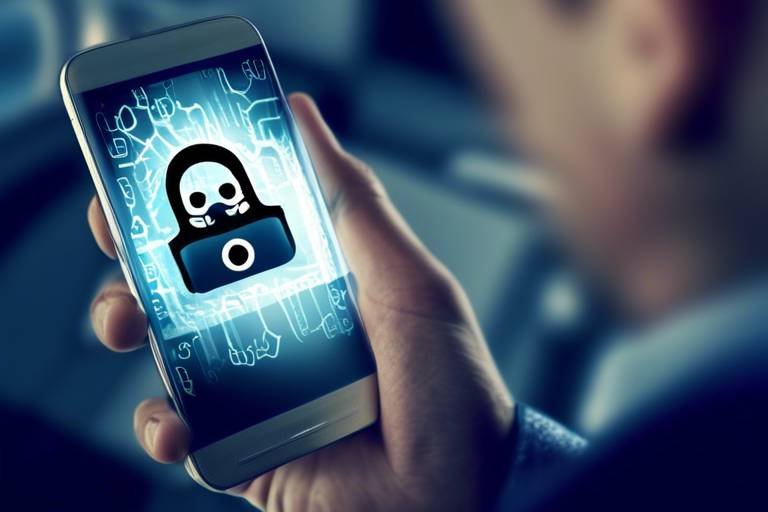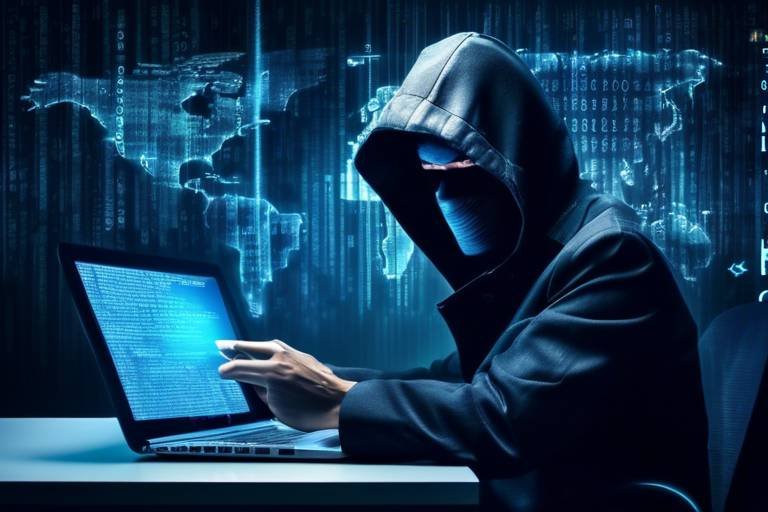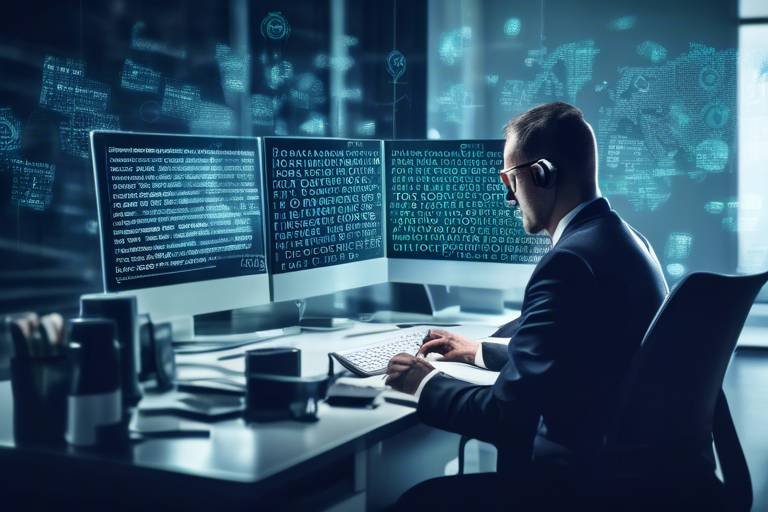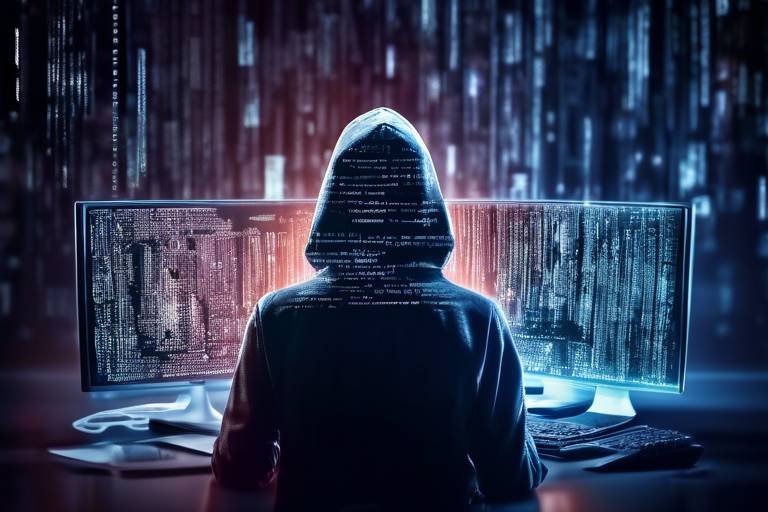The Connection Between Physical and Digital Security
In today's fast-paced world, the line between physical security and digital security is becoming increasingly blurred. Organizations are realizing that to effectively protect their assets, they must consider both realms as interconnected rather than isolated entities. Imagine a fortress with high walls and guards at the gate, yet its digital doors are wide open to cyber intruders. This scenario illustrates the critical need for an integrated approach to security. By combining physical security measures—like controlled access to buildings and surveillance systems—with robust digital protocols such as firewalls and encryption, organizations can create a comprehensive security strategy that addresses a myriad of threats.
But what does this integration really look like in practice? Think of it as a two-sided coin. On one side, you have physical security, which includes everything from locks on doors to security personnel monitoring premises. On the other side, you have digital security, which encompasses firewalls, antivirus software, and secure passwords. Both sides must work harmoniously to ensure that a breach in one does not compromise the other. For instance, if a hacker gains access to a company's network through weak digital security, they may be able to manipulate physical security systems, such as disabling alarms or unlocking doors.
Furthermore, the potential impact of a security breach can be catastrophic. A single incident can lead to significant financial losses, damage to reputation, and even legal repercussions. Therefore, organizations must adopt a holistic approach that encompasses both physical and digital security measures. This strategy not only ensures the safety of physical assets but also protects sensitive data and information from falling into the wrong hands.
To illustrate the importance of this connection, consider the following table that highlights the relationship between physical and digital security measures:
| Physical Security Measures | Digital Security Measures |
|---|---|
| Access control systems (e.g., key cards) | Firewall protection |
| Surveillance cameras | Intrusion detection systems |
| Security personnel | Cybersecurity training for employees |
| Alarm systems | Data encryption |
In conclusion, the connection between physical and digital security is not just a trend; it's a necessity in our interconnected world. Organizations that recognize this relationship and invest in integrated security strategies will not only protect their assets but also foster a culture of security awareness among their employees, ensuring a safer environment for everyone.

The Importance of Integrated Security
In today's fast-paced world, the line between physical security and digital security is increasingly blurred. Organizations must recognize that these two realms are not isolated; rather, they are interdependent components of a comprehensive security strategy. Imagine trying to protect a castle without fortifying its gates while simultaneously leaving the treasure room unguarded. It simply doesn’t make sense, does it? By integrating physical and digital security measures, organizations can create a robust defense against a multitude of threats.
Understanding the significance of integrated security is akin to weaving a safety net that catches not only the obvious risks but also the hidden ones. When physical security measures, such as surveillance cameras and access controls, are combined with digital security protocols like firewalls and encryption, organizations can effectively mitigate risks and respond to threats in real-time. This holistic approach ensures that every layer of security is fortified, providing a seamless transition between protecting physical assets and safeguarding digital information.
Moreover, the benefits of integrated security extend beyond mere risk mitigation. It also enhances operational efficiency. When security systems are interconnected, organizations can streamline their processes, making it easier to monitor and manage security incidents. For instance, if a physical breach occurs, the digital systems can automatically lock down sensitive data, preventing unauthorized access. This synergy not only protects assets but also fosters a culture of safety within the organization.
To put this into perspective, consider the following key points that highlight the importance of integrated security:
- Comprehensive Risk Management: By addressing both physical and digital vulnerabilities, organizations can reduce the likelihood of breaches.
- Improved Incident Response: Integrated systems allow for quicker and more effective responses to security incidents.
- Cost Efficiency: Streamlining security measures can lead to reduced costs in training, technology, and incident management.
In conclusion, the integration of physical and digital security is not just a trend; it is a necessity in the modern security landscape. Organizations that fail to recognize this connection risk leaving themselves vulnerable to a myriad of threats. By adopting an integrated approach, they can ensure a safer environment for their assets, employees, and customers, ultimately leading to a more resilient and secure future.
- What is integrated security?
Integrated security refers to the combination of physical and digital security measures to protect an organization’s assets and information. - Why is integrated security important?
It is crucial because it allows organizations to address vulnerabilities in both realms, enhancing overall protection and improving incident response. - How can organizations implement integrated security?
Organizations can start by conducting a thorough risk assessment, investing in technology that bridges both security domains, and fostering a culture of security awareness among employees.

Common Threats to Physical and Digital Security
In today’s interconnected world, the lines between physical and digital security have blurred, creating a complex landscape of threats that organizations must navigate. It's essential to understand these threats because they can come from various angles, and a single vulnerability can lead to a catastrophic breach. Whether it's a hacker exploiting a weak password or an unauthorized individual gaining access to a restricted area, the implications can be severe. Organizations need to be aware of the common threats that can undermine their security posture.
One of the most pressing issues is cybersecurity breaches. These breaches can occur when malicious actors infiltrate an organization's digital infrastructure, often through phishing attacks or exploiting software vulnerabilities. The consequences can be devastating, including loss of sensitive data, financial penalties, and irreparable damage to an organization’s reputation. To put it in perspective, imagine your house being broken into; the feeling of vulnerability and loss is similar when a company faces a cyber breach.
On the flip side, physical security threats can also have dire repercussions for digital security. For instance, if a thief breaks into an office and steals a computer, they may gain access to sensitive data stored on that device. This highlights the need for a coordinated approach to security that addresses both physical and digital realms. Organizations must consider threats such as:
- Theft of hardware
- Vandalism of physical assets
- Unauthorized access to facilities
Moreover, environmental factors pose another layer of risk. Natural disasters, such as floods or fires, can damage physical infrastructure, leading to potential data loss if proper backups and disaster recovery plans are not in place. In this way, the physical environment directly impacts digital security, making it crucial for organizations to implement environmental security measures that protect both their physical assets and digital information.
To sum it up, the threats to physical and digital security are multifaceted and interconnected. Organizations must adopt a holistic approach to security, recognizing that vulnerabilities in one area can significantly impact another. By understanding these common threats, businesses can better prepare themselves to defend against breaches, theft, and unauthorized access, ensuring a more secure operational environment.
- What is the difference between physical and digital security?
Physical security involves protecting tangible assets, such as buildings and equipment, while digital security focuses on safeguarding data and information systems from cyber threats. - How can organizations integrate physical and digital security?
Organizations can integrate security by implementing access control measures that encompass both physical entry points and digital systems, ensuring a comprehensive security strategy. - What are some examples of physical security measures?
Examples include surveillance cameras, security guards, access control systems, and secure locks. - What steps can organizations take to mitigate cybersecurity threats?
Regularly updating software, conducting employee training, and implementing strong password policies are effective ways to reduce cybersecurity risks.

Cybersecurity Breaches
In today's interconnected world, the threat of looms larger than ever. These breaches can wreak havoc on an organization, leading to financial losses, reputational damage, and a significant loss of trust among customers and stakeholders. Imagine waking up to find that your sensitive data has been compromised; the feeling is akin to discovering that your front door was left wide open all night. It's a breach of security that can leave you feeling vulnerable and exposed.
Cybersecurity breaches occur when unauthorized individuals gain access to sensitive information, often exploiting weaknesses in both physical and digital security measures. These breaches can take many forms, including:
- Phishing Attacks: Deceptive emails designed to trick individuals into revealing personal information.
- Malware Infiltration: Malicious software that can disrupt operations and steal data.
- Ransomware: A type of malware that encrypts data, demanding payment for its release.
The consequences of such breaches can be staggering. According to recent reports, the average cost of a data breach is estimated to be around $4.24 million. This figure encompasses various expenses, including legal fees, regulatory fines, and the costs associated with restoring compromised systems. Furthermore, the long-term effects can be even more damaging, as companies often struggle to regain customer trust after a breach. It's like trying to rebuild a shattered vase; no matter how well you piece it back together, the cracks remain visible.
To combat these threats, organizations must adopt a comprehensive security strategy that addresses both physical and digital vulnerabilities. This includes implementing robust cybersecurity protocols, such as:
- Regular Software Updates: Keeping systems up-to-date to protect against known vulnerabilities.
- Multi-Factor Authentication: Adding an extra layer of security to user access.
- Data Encryption: Protecting sensitive information by converting it into a secure format.
Moreover, the integration of physical security measures is crucial. For instance, ensuring that server rooms are secured with access controls can prevent unauthorized personnel from tampering with critical systems. This holistic approach not only fortifies the digital landscape but also creates a safer physical environment, making it significantly harder for threats to penetrate.
In conclusion, the threat of cybersecurity breaches is a reality that organizations cannot afford to ignore. By understanding the nature of these threats and implementing a well-rounded security strategy, businesses can protect their assets and ensure a safer operating environment. After all, in the game of security, it's better to be proactive than reactive.
Q: What are the most common types of cybersecurity breaches?
A: The most common types include phishing attacks, malware infiltration, and ransomware attacks.
Q: How can organizations prevent cybersecurity breaches?
A: Organizations can prevent breaches by implementing strong cybersecurity protocols, conducting regular security audits, and ensuring physical security measures are in place.
Q: What should I do if my organization experiences a cybersecurity breach?
A: It's essential to have an incident response plan in place. Immediately isolate affected systems, notify relevant stakeholders, and begin the process of assessing and mitigating the damage.

Physical Access Control
When it comes to safeguarding sensitive areas within an organization, is a cornerstone of security strategy. Imagine a fortress with towering walls and a single gate; if that gate is weak, the fortress is vulnerable. Similarly, organizations must ensure that their entry points are fortified to prevent unauthorized access. This is where robust physical access control measures come into play. They not only protect physical assets but also serve as a crucial line of defense for digital systems, creating a layered security approach.
Physical access control encompasses a variety of methods and technologies designed to restrict entry to authorized personnel only. From traditional key locks to advanced biometric systems, organizations have a plethora of options to choose from. For instance, biometric systems such as fingerprint scanners and facial recognition technology provide a high level of security by ensuring that only individuals with verified identities can gain access. This is akin to having a personal bodyguard who only lets in trusted friends.
Moreover, implementing access control systems can significantly enhance an organization’s ability to monitor and manage who enters and exits premises. These systems can log entry and exit times, track movements within secure areas, and even integrate with digital security protocols to trigger alerts in case of unauthorized access attempts. The combination of physical and digital monitoring creates a comprehensive security net that can detect threats before they escalate.
One of the key benefits of physical access control is its ability to limit exposure to sensitive information and systems. By restricting access to only those who need it, organizations can minimize the risk of data breaches and theft. Consider a bank vault: only a select few have the combination to enter, thus protecting the valuable assets inside. Similarly, organizations should establish clear policies regarding who is allowed access to critical systems and sensitive areas.
In addition to technology, the human element plays a vital role in physical access control. Employee training and awareness are essential components of a successful access control strategy. Staff should be educated about the importance of maintaining security protocols, such as not sharing access cards or codes, and being vigilant about who is around them. This culture of awareness can act as an additional layer of defense, ensuring that everyone is engaged in the security process.
In summary, physical access control is not just about locking doors; it’s about creating a secure environment that protects both physical and digital assets. By leveraging advanced technologies, establishing strict access policies, and fostering a culture of security awareness, organizations can significantly enhance their overall security posture. As threats evolve, so too must the strategies to counter them, making physical access control an indispensable part of any comprehensive security plan.
- What is physical access control?
Physical access control refers to the measures and technologies used to restrict access to secure areas and sensitive information, ensuring that only authorized individuals can enter. - Why is physical access control important?
It is crucial for protecting both physical and digital assets, minimizing risks of theft, data breaches, and unauthorized access. - What technologies are used in physical access control?
Common technologies include key cards, biometric scanners, PIN code entry systems, and surveillance cameras. - How can organizations improve their physical access control?
By implementing advanced technologies, establishing strict access policies, and training employees on security awareness.

Environmental Security Measures
In today's world, where the lines between physical and digital security are increasingly blurred, have emerged as a critical component of a comprehensive security strategy. These measures do not merely focus on the physical barriers that protect facilities but also encompass systems designed to safeguard digital assets from physical threats. Imagine your organization as a fortress; while the walls keep intruders at bay, it’s the moat and the drawbridge that ensure only the right people can enter.
One of the most effective ways to bolster security is through the implementation of advanced surveillance systems. These systems offer real-time monitoring capabilities, allowing security personnel to keep an eye on sensitive areas. For instance, a well-placed camera can deter potential intruders and provide valuable footage in the event of an incident. Moreover, integrating these systems with digital security protocols means that any suspicious activity can trigger alerts across both physical and digital platforms, ensuring a swift response.
Additionally, secure facilities play a pivotal role in environmental security. This involves not only the physical structure but also the protocols that govern access to these areas. For example, using access control technologies such as biometric systems can ensure that only authorized personnel have access to sensitive zones. This creates a layered defense that not only protects physical assets but also secures the digital information housed within those facilities. A secure facility can be likened to a bank vault, where both the physical and digital keys are needed to unlock the treasures inside.
Furthermore, organizations should consider implementing environmental monitoring systems. These systems can detect changes in temperature, humidity, and even unauthorized access attempts, providing a holistic view of the security landscape. By monitoring environmental factors, organizations can prevent damage to critical infrastructure, which in turn protects the digital assets that rely on that infrastructure. For example, a sudden spike in temperature could indicate a fire hazard, prompting immediate action to protect both physical and digital resources.
In summary, the combination of surveillance systems, secure facilities, and environmental monitoring creates a robust defense mechanism that addresses both physical and digital vulnerabilities. Organizations need to recognize that their security strategy must be as dynamic as the threats they face. By investing in environmental security measures, they can create a safer operating environment that not only protects their assets but also fosters trust among stakeholders.
- What are environmental security measures?
Environmental security measures refer to systems and protocols designed to protect both physical and digital assets from threats that can arise from the surrounding environment. - How do surveillance systems contribute to security?
Surveillance systems provide real-time monitoring, which helps in detecting unauthorized access and can trigger alerts to ensure a quick response to potential threats. - Why is access control important?
Access control is crucial as it ensures that only authorized personnel can enter sensitive areas, thereby protecting both physical and digital information. - What role does environmental monitoring play?
Environmental monitoring helps detect changes that could indicate security risks, such as temperature spikes, which can prevent damage to critical infrastructure.

Physical Security Threats
When we think about security, our minds often jump straight to the digital realm—firewalls, encryption, and antivirus software. However, it's crucial not to overlook the lurking dangers in the physical world. Physical security threats can have a profound impact on an organization’s overall safety and integrity. Imagine a thief breaking into a facility and accessing sensitive information stored on a server. It's a scenario that highlights the interconnectedness of physical and digital security.
Physical security threats come in various forms, and understanding these threats is the first step toward building a robust security strategy. Here are some of the most common physical security threats:
- Theft: This isn't just about stealing physical assets; it can also involve data theft, where unauthorized individuals gain access to confidential information.
- Vandalism: Damage to property can disrupt operations and lead to significant financial losses. Vandalism can also compromise security systems, making them less effective.
- Unauthorized Access: When individuals gain entry to restricted areas, they can manipulate systems or steal sensitive data, posing a severe risk to organizational security.
- Natural Disasters: Events like floods, earthquakes, or fires can physically damage facilities and disrupt digital operations, highlighting the need for contingency planning.
Each of these threats poses unique challenges, and their implications can ripple through an organization. For instance, a theft incident might not only result in immediate loss but can also damage the organization’s reputation, leading to a decline in customer trust. Similarly, if unauthorized personnel access critical systems, they could manipulate data or steal intellectual property, resulting in long-term repercussions.
Moreover, physical security threats can also create vulnerabilities in digital security protocols. For example, if a server room is not adequately secured and someone gains access, they can easily bypass digital security measures. This makes it imperative for organizations to adopt a holistic approach to security that encompasses both physical and digital dimensions.
To effectively combat these threats, organizations must invest in comprehensive physical security measures. This includes installing surveillance cameras, implementing access control systems, and conducting regular security assessments to identify vulnerabilities. By doing so, organizations not only protect their physical assets but also enhance their digital security posture, creating a fortified environment against a myriad of threats.
In conclusion, recognizing and addressing physical security threats is vital for any organization aiming to maintain a secure and resilient operational framework. By understanding these threats and integrating physical security with digital protocols, organizations can create a comprehensive security strategy that safeguards their assets and information.
- What are the most common physical security threats?
The most common threats include theft, vandalism, unauthorized access, and natural disasters. - How can organizations protect against physical security threats?
Organizations can protect themselves by implementing surveillance systems, access control measures, and conducting regular security audits. - Why is it important to integrate physical and digital security?
Integrating both types of security helps to create a comprehensive strategy that addresses vulnerabilities in both realms, thereby enhancing overall security.

Best Practices for Security Integration
In today's fast-paced world, where threats can emerge from both the physical and digital realms, organizations must prioritize the integration of security measures. This isn't just about putting up walls or installing firewalls; it's about creating a seamless strategy that combines the best of both worlds. Imagine your security system as a well-oiled machine, where every part works in harmony to protect your assets and information. To achieve this, there are several best practices that organizations should adopt.
First and foremost, fostering a culture of security awareness among employees is crucial. When everyone understands the importance of security protocols, they become the first line of defense against potential threats. Regular training sessions can help employees recognize suspicious activities, whether it's an unauthorized person trying to access a restricted area or a phishing email that could compromise digital security. By empowering staff with knowledge, organizations can significantly reduce vulnerabilities.
Another key practice is conducting regular security audits. These audits serve as a health check for your security measures, allowing you to identify weaknesses and areas for improvement. It’s essential to evaluate both physical and digital security protocols to ensure they complement each other effectively. For instance, if a physical access point is left unguarded, it could provide an opening for cybercriminals to exploit digital systems. A comprehensive audit will help you spot these gaps and address them promptly.
Furthermore, integrating technology into your security strategy can enhance overall protection. Advanced surveillance systems, for example, not only deter physical threats but also provide valuable data that can be analyzed for digital security insights. Imagine having a system that alerts you not just to a break-in but also to unusual digital activity happening simultaneously. This level of integration can be achieved through modern security technologies that bridge the gap between physical and digital realms.
Moreover, it's important to establish clear communication channels within your organization. In the event of a security incident, rapid communication can make all the difference. Ensure that your teams—both physical security and IT—are in sync and can share information quickly. This could mean having a dedicated communication platform where incidents can be reported and tracked in real time. By fostering collaboration, you create a more resilient security posture.
Lastly, consider implementing access control technologies that reinforce both physical and digital security. Biometric systems, smart cards, and other advanced technologies ensure that only authorized personnel can access sensitive areas and information. This not only protects physical spaces but also secures the digital assets contained within. By controlling access, you minimize the risk of internal and external threats.
By adopting these best practices for security integration, organizations can create a robust framework that not only protects their assets but also fosters a culture of vigilance and preparedness. Remember, in the world of security, it's not just about defense; it's about creating a proactive and responsive environment that can adapt to ever-evolving threats.
- What is security integration? Security integration refers to the process of combining physical and digital security measures to create a cohesive strategy that safeguards an organization's assets and information.
- Why is employee training important for security integration? Employee training is crucial because it equips staff with the knowledge to recognize and respond to potential threats, making them an essential part of the security strategy.
- How often should security audits be conducted? Regular security audits should be conducted at least annually, but more frequent assessments may be necessary depending on the organization's size and the nature of its operations.
- What role does technology play in security integration? Technology enhances security integration by providing tools for monitoring, access control, and incident management, allowing organizations to respond more effectively to threats.

Employee Training and Awareness
In today's fast-paced world, where threats can emerge from both physical and digital realms, the significance of cannot be overstated. Imagine your organization as a fortress; no matter how robust your walls are, if the guards are unaware of their surroundings or the protocols in place, you're still vulnerable to an attack. Training employees on security protocols is akin to equipping them with the knowledge and skills to act as vigilant sentinels, ready to defend against potential threats.
When employees are well-informed about security measures, they become the first line of defense. They can identify suspicious activities, understand the importance of reporting incidents, and recognize the signs of potential breaches. This culture of vigilance fosters a proactive environment where everyone plays a role in safeguarding the organization’s assets, both physical and digital. For instance, consider the scenario where an employee notices an unfamiliar person lingering around a server room. With proper training, they would know to report this immediately, potentially thwarting a security breach before it escalates.
Moreover, training should not be a one-time event. It needs to be an ongoing process that adapts to the evolving security landscape. Organizations can implement regular training sessions, workshops, and simulations to keep employees engaged and informed. Here are some key components that should be included in any effective training program:
- Understanding Security Policies: Employees should be familiar with the organization's security policies and procedures, including how to handle sensitive information.
- Recognizing Threats: Training should cover various types of threats, such as phishing attacks, social engineering, and physical security breaches.
- Incident Reporting: Employees need to know how to report suspicious activities or security incidents promptly.
- Best Practices: Regular reminders about password management, safe browsing habits, and secure handling of physical assets are essential.
Additionally, organizations can leverage technology to enhance training effectiveness. For example, implementing an online training portal can provide employees with easy access to resources, quizzes, and updates on security trends. Gamification of training modules can also increase engagement, turning learning into an interactive experience that employees look forward to.
In conclusion, investing in employee training and awareness is not just a checkbox on a compliance list; it’s a critical component of a comprehensive security strategy. By fostering a culture of security awareness, organizations can significantly reduce their vulnerability to both physical and digital threats, ensuring that all employees are equipped to contribute to a safer workplace.
Q: Why is employee training important for security?
A: Employee training is crucial because it equips staff with the knowledge to recognize and respond to potential security threats, thus serving as the first line of defense for the organization.
Q: How often should security training be conducted?
A: Security training should be an ongoing process, with regular updates and refreshers provided at least annually, or more frequently as new threats emerge.
Q: What topics should be covered in security training?
A: Training should cover security policies, threat recognition, incident reporting procedures, and best practices for both physical and digital security.
Q: Can technology aid in employee training?
A: Yes, technology can enhance training through online portals, interactive modules, and gamification, making learning more engaging and accessible.

Regular Security Audits
In today’s rapidly evolving threat landscape, conducting is not just a good practice; it’s an essential part of any comprehensive security strategy. Think of security audits as a health check-up for your organization’s security posture. Just like you wouldn’t ignore the doctor’s advice to get regular check-ups, your organization shouldn’t overlook the necessity of auditing its security measures. These audits serve as a proactive approach to identifying vulnerabilities and ensuring that both physical and digital security protocols are functioning as intended.
During a security audit, organizations evaluate their existing security policies, procedures, and technologies. This process typically includes a thorough examination of both physical and digital assets, ensuring that every aspect of security is scrutinized. The goal? To pinpoint gaps that could potentially be exploited by malicious actors. For instance, if an organization has robust digital security but lax physical controls, it may be leaving itself open to breaches that could easily occur if someone gains unauthorized access to sensitive areas.
One of the key benefits of regular security audits is the ability to adapt to evolving threats. Cybercriminals are constantly developing new tactics, and what worked a year ago may not be sufficient today. By routinely assessing security measures, organizations can stay one step ahead of potential threats. This is especially critical in a world where data breaches can lead to significant financial loss and reputational damage.
Moreover, regular audits foster a culture of accountability and vigilance within the organization. When employees see that their organization takes security seriously, it encourages them to adopt a proactive approach towards security in their daily activities. This cultural shift can be invaluable in creating a workforce that is not just aware of security protocols but actively participates in maintaining them.
To illustrate the importance of regular security audits, consider the following table that outlines the key components and benefits of conducting these audits:
| Audit Component | Benefits |
|---|---|
| Policy Review | Ensures policies are up-to-date and relevant to current threats. |
| Vulnerability Assessment | Identifies weaknesses in both physical and digital security. |
| Compliance Check | Ensures adherence to relevant regulations and standards. |
| Incident Response Evaluation | Assesses the effectiveness of response plans and procedures. |
In conclusion, regular security audits are a vital component of an integrated security strategy. They not only help in identifying vulnerabilities but also play a crucial role in adapting to new threats and fostering a culture of security awareness. By committing to these audits, organizations can significantly enhance their resilience against potential breaches, ensuring both their physical and digital assets are well-protected.
- What is a security audit?
A security audit is a systematic evaluation of an organization's security policies, procedures, and controls to identify vulnerabilities and ensure compliance with regulations. - How often should security audits be conducted?
It is recommended to conduct security audits at least annually, or more frequently if there are significant changes in the organization or its environment. - What are the key components of a security audit?
Key components include policy reviews, vulnerability assessments, compliance checks, and incident response evaluations. - Who should conduct the security audit?
Audits can be conducted internally by a dedicated security team or externally by third-party security experts for an unbiased perspective.

The Role of Technology in Security
In today's fast-paced world, the interplay between physical and digital security has become more crucial than ever. Technology serves as the backbone of this synergy, offering innovative solutions that not only enhance protective measures but also streamline processes for organizations. Imagine walking into a high-tech facility where every corner is monitored, every access point is secured, and every piece of data is protected by layers of advanced technology. This is not just a dream; it's the reality that organizations are striving to achieve by leveraging modern security technologies.
One of the most significant advancements in security technology is the development of surveillance systems. These systems have evolved from simple camera setups to sophisticated networks capable of real-time monitoring and data analytics. With features like motion detection, facial recognition, and remote access, organizations can instantly identify and respond to potential threats. For instance, a security camera equipped with artificial intelligence can analyze footage and alert security personnel if it detects unusual behavior. This proactive approach not only enhances physical security but also protects digital assets, as breaches often start with unauthorized access to physical locations.
Moreover, access control technologies are revolutionizing the way organizations manage entry to sensitive areas. Traditional lock-and-key methods are being replaced by more secure solutions such as biometric systems and smart cards. These technologies ensure that only authorized personnel can access critical areas, effectively bridging the gap between physical and digital security. Biometric systems, for example, use unique identifiers like fingerprints or facial features, making it nearly impossible for unauthorized individuals to gain entry. This is vital in protecting not just physical spaces but also the digital information stored within those environments.
To illustrate the impact of technology on security, consider the following table that outlines various technological solutions and their benefits:
| Technology | Benefits |
|---|---|
| Surveillance Systems | Real-time monitoring, threat detection, data analysis |
| Access Control Technologies | Enhanced security, restricted access, user verification |
| Alarm Systems | Immediate alerts, deterrence of intruders, emergency response |
| Cybersecurity Software | Protection against digital threats, data encryption, network monitoring |
Furthermore, technology plays a pivotal role in incident management. With the integration of digital platforms, organizations can streamline their response to security breaches. Imagine a scenario where an alarm goes off, and within seconds, the security team receives alerts on their mobile devices, along with real-time video feeds from surveillance cameras. This level of coordination not only speeds up the response time but also ensures that all necessary protocols are followed, reducing the chances of human error.
In conclusion, the role of technology in security cannot be overstated. It acts as a force multiplier, enhancing both physical and digital security measures. By adopting advanced technologies, organizations can create a comprehensive security strategy that not only protects their assets but also instills confidence among employees and stakeholders. In a world where threats are becoming increasingly sophisticated, the integration of technology is not just an option; it is a necessity for survival and success.
- What is the importance of integrating physical and digital security?
Integrating both types of security helps organizations mitigate risks, respond effectively to threats, and ensure a holistic approach to safeguarding assets and information. - How do surveillance systems enhance security?
Surveillance systems provide real-time monitoring and data collection, enabling organizations to detect and respond to threats that may impact both physical and digital assets. - What are access control technologies?
Access control technologies include biometric systems and smart cards that enhance security by ensuring that only authorized personnel can access sensitive areas and information. - Why is employee training important for security?
Training fosters a culture of vigilance, equipping employees to recognize and respond to potential threats in both physical and digital environments.

Surveillance Systems
In today's fast-paced world, have become an essential component of both physical and digital security strategies. These systems are not just about watching over a space; they are about creating a comprehensive security environment that protects assets, information, and people. Imagine a fortress where every corner is monitored, every entry point is secured, and every movement is recorded. This is the kind of assurance that advanced surveillance systems provide, acting as the eyes and ears of an organization.
Modern surveillance systems go beyond traditional cameras. They incorporate high-definition video recording, motion detection, and even artificial intelligence to analyze behavior and detect anomalies. This means that organizations can not only capture footage but also gain insights into potential threats before they escalate. For example, a system equipped with AI can learn the usual patterns of activity and alert security personnel when something unusual occurs, much like a guard who knows the regulars but raises an alarm when a stranger appears.
Furthermore, the integration of surveillance systems with digital security measures creates a seamless flow of information. When a breach occurs, whether physical or digital, the data collected by surveillance systems can be invaluable. It can provide context to an incident, helping organizations respond more effectively. For instance, if a cyber attack is detected, reviewing surveillance footage might reveal if there was a physical breach that allowed an intruder to access sensitive areas.
Here are some key components of modern surveillance systems that enhance security:
- Real-Time Monitoring: Security personnel can monitor feeds from various locations simultaneously, allowing for quick responses to potential threats.
- Remote Access: With cloud technology, authorized personnel can access live feeds and recorded footage from anywhere, making it easier to manage security on the go.
- Integration with Alarm Systems: When surveillance detects unauthorized access, it can trigger alarms, ensuring a swift response.
- Analytics and Reporting: Many systems now offer analytical tools that provide insights into traffic patterns, peak times for activity, and other valuable data.
Moreover, the physical placement of surveillance cameras is crucial. They should be strategically positioned to cover high-risk areas such as entrances, exits, and sensitive zones within the organization. This is akin to setting up a chessboard; every piece has its role, and their placement can mean the difference between winning and losing. By effectively utilizing surveillance systems, organizations can create a robust security posture that not only deters potential threats but also provides a rapid response mechanism when incidents occur.
In conclusion, surveillance systems are not just a reactive measure; they are a proactive strategy that enhances both physical and digital security. By investing in advanced surveillance technology, organizations can safeguard their assets and ensure a safer environment for employees and clients alike. As the landscape of security continues to evolve, embracing these technologies will be key to staying ahead of potential threats.
- What types of surveillance systems are available? There are various types, including CCTV cameras, IP cameras, and smart surveillance systems that use AI for analysis.
- How do surveillance systems enhance digital security? They provide real-time monitoring and data that can help identify physical breaches that may lead to digital threats.
- Can surveillance footage be accessed remotely? Yes, many modern systems allow for remote access via secure cloud platforms.
- What should organizations consider when installing surveillance systems? They should consider camera placement, integration with existing security systems, and compliance with privacy laws.

Access Control Technologies
Access control technologies are revolutionizing the way organizations protect their sensitive information and physical spaces. In today's digital age, where data breaches and unauthorized access are rampant, these technologies serve as a crucial line of defense. Imagine a fortress where only trusted allies can enter; this is precisely what access control systems aim to achieve for your organization. By utilizing advanced methods, companies can ensure that only authorized personnel have the keys to their digital and physical domains.
One of the most prominent access control technologies is biometric systems. These systems use unique biological traits—like fingerprints, facial recognition, or iris scans—to verify identity. The beauty of biometrics lies in its complexity; it’s nearly impossible to replicate someone’s fingerprint or iris. This technology not only enhances security but also simplifies the access process, eliminating the need for traditional keys or cards that can be lost or stolen. Consider this: would you rather trust a key that can be duplicated or a fingerprint that is uniquely yours?
Another effective technology is the use of smart cards. These cards contain embedded microchips that store encrypted information, allowing for secure access to both physical locations and digital systems. Organizations can easily manage who has access to what by programming these cards, making it a flexible solution for changing security needs. For instance, if an employee leaves, their access rights can be quickly revoked without the need to change locks or reissue keys.
Moreover, cloud-based access control systems are gaining traction as they offer centralized management of access rights from anywhere in the world. This is particularly beneficial for organizations with multiple locations or remote workers. With cloud technology, administrators can monitor and manage access in real-time, ensuring that security measures are always up to date. Imagine having the power to lock or unlock doors, or grant access to sensitive information, all from your smartphone—this is the future of security!
To illustrate the effectiveness of these technologies, consider the following table that compares traditional access methods with modern access control technologies:
| Access Method | Security Level | Convenience | Cost |
|---|---|---|---|
| Traditional Keys | Low | High | Low |
| Keycards | Medium | Medium | Medium |
| Biometric Systems | High | High | High |
| Cloud-Based Systems | Very High | Very High | Medium |
In conclusion, access control technologies are not just about keeping unauthorized individuals out; they are about creating a secure environment where only the right people have access to the right resources. As organizations continue to evolve in the face of emerging threats, investing in these technologies is not merely an option; it is a necessity. By implementing robust access control measures, companies can protect their assets, enhance their operational efficiency, and ultimately foster a culture of security that permeates every level of the organization.
- What are access control technologies?
Access control technologies are systems designed to restrict access to physical and digital resources to authorized individuals only. - How do biometric systems work?
Biometric systems utilize unique biological traits, such as fingerprints or facial recognition, to verify a person's identity. - What are the benefits of using smart cards?
Smart cards offer enhanced security, flexibility in managing access rights, and ease of use, making them a popular choice for organizations. - Can cloud-based access control systems be managed remotely?
Yes, cloud-based systems allow for remote management of access rights, enabling real-time monitoring and adjustments from anywhere.
Frequently Asked Questions
- What is the relationship between physical and digital security?
The relationship between physical and digital security is deeply intertwined. While physical security focuses on protecting tangible assets from threats like theft or vandalism, digital security safeguards information and systems from cyber threats. Together, they create a comprehensive security strategy that addresses vulnerabilities across both domains, ensuring that an organization is well-protected from all angles.
- Why is it important to integrate physical and digital security?
Integrating physical and digital security is essential for organizations to effectively mitigate risks. By combining these approaches, businesses can respond more efficiently to threats, ensuring that both their physical assets and digital information are safeguarded. This holistic view allows for better resource allocation, streamlined processes, and improved incident response capabilities, ultimately enhancing overall security posture.
- What are some common threats to physical and digital security?
Common threats to physical and digital security include cybersecurity breaches, unauthorized access, theft, vandalism, and environmental hazards. These threats can compromise both physical assets and digital systems, leading to significant financial and reputational damage. Organizations must recognize these vulnerabilities and implement measures to protect against them effectively.
- How can employee training improve security measures?
Employee training is crucial for fostering a culture of security awareness. When employees are educated about security protocols and potential threats, they become more vigilant and capable of recognizing suspicious activities in both physical and digital environments. This proactive approach can significantly reduce the risk of security breaches and enhance the overall effectiveness of security measures.
- What role does technology play in enhancing security?
Technology plays a pivotal role in enhancing both physical and digital security. Advanced surveillance systems provide real-time monitoring, while access control technologies, like biometric systems, ensure that only authorized personnel can access sensitive areas. By leveraging innovative solutions, organizations can streamline their security processes, improve incident management, and better protect their assets.
- What are some best practices for integrating security measures?
Some best practices for integrating security measures include conducting regular security audits, implementing robust access control systems, and fostering a culture of security awareness among employees. These practices help organizations identify vulnerabilities, ensure compliance with security protocols, and create a cohesive security strategy that addresses both physical and digital threats.



















